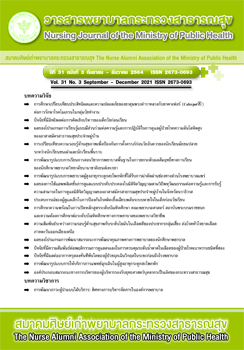Factors Influencing the Sudden Deterioration of Emergency Critical Patients in Pre-hospital Care Period
Main Article Content
Abstract
The aim of this study was to determine the factors influencing clinical deterioration during the prehospital care phase in critically ill patients who used the emergency medical system in Phrae province. This cross-sectional analytical study included 299 patients who were categorized as " red" (emergency) and "yellow" (urgent) by telephone triage, received on-site care from emergency medical personnel, and were transferred to Phrae Hospital. Data were collected retrospectively by reviewing patients' medical records and referral documentation from November 2019 to April 2020. Data were analyzed using t-test, Wilcoxon rank sum test and logistic regression analysis. The results showed that 25.63% of participants developed clinical deterioration. In the logistic regression analysis, patients over 60 years of age had a 6.16-fold higher risk of clinical deterioration (95% CI = 2.07-18.31). Patients with one underlying disease and two or more underlying diseases had a 3.82-fold risk (95% CI = 1.63-8.96) and a 3.51-fold risk (95% CI = 1.23-10.06) of clinical deterioration, respectively. Similarly, an on-scene of systolic blood pressure less than 90 mmHg resulted in a 7.73-fold risk of clinical deterioration (95% CI = 2.52-23.69). On-scene of the time greater than 10 minutes resulted in a 2.09-fold risk of clinical deterioration (95% CI = 1.04-1.16). These findings can be used to develop a guide for healthcare providers for on-scene assessment and care to prevent the occurrence of clinical deterioration in critically ill patients during a prehospital crisis.
Article Details
บทความและรายงานวิจัยในวารสารพยาบาลกระทรวงสาธารณสุข เป็นความคิดเห็นของ ผู้เขียน มิใช่ของคณะผู้จัดทำ และมิใช่ความรับผิดชอบของสมาคมศิษย์เก่าพยาบาลกระทรวงสาธารณสุข ซึ่งสามารถนำไปอ้างอิงได้
References
2. Page C, Sbat M, Vazquez K, Yalcin ZD. Analysis of emergency medical systems across the world. BSc project submitted to Worcester Polytechnic Institute.2013.
3. Kronick LS, Kurz CM, Lin S, Edelson PD, Berg AR, Billi EJ, et al. Part 4: Systems of care and continuous quality improvement 2015 American heart association guidelines update for cardiopulmonary resuscitation and emergency cardiovascular care. Circulation 2015;132(18 suppl 2):S397-S413.
4. National Institute for Emergency Medicine. Gap of emergency medical in Thailand: Annual report 2016. Bangkok: Punchamit.2016.(in Thai).
5. Clawson A, Stewart P, Freitag S. Public expectations of receiving telephone pre-arrival instructions from emergency medical dispatchers at 3 decades post origination at first scripted site. THE JOURNAL 2011;35.
6. Dami F, Golay C, Pasquier M, Fuchs V, Carron NP, Hugli O. Prehospital triage accuracy in a criteria based dispatch centre. BMC emergency medicine 2015;15(1):1-9.
7. McNally B, Robb R, Mehta M, Vellano K, Valderrama AL, Yoon PW, et al. Out-of-hospital cardiac arrest surveillance cardiac arrest registry to enhance survival (CARES), United States, October 1, 2005 December 31, 2010. Morbidity and mortality weekly report: surveillance summaries 2011;60(8):1-19.
8. Sanghavi P, Jena BA, Newhouse PJ, Zaslavsky MA. Outcomes after out of hospital cardiac arrest treated by basic vs advanced life support. JAMA internal medicine 2015;175(2):196-204.
9. Javali RH, Krishnamoorthy AP, Srinivasarangan M, Suraj S. Comparison of injury severity score, new injury severity score, revised trauma score and trauma and injury severity score for mortality prediction in elderly trauma patients. Indian journal of critical care medicine: peer-reviewed, official publication of Indian Society of Critical Care Medicine.2019;23(2):73.
10. Patel DM, Rose MK, O’Brien CE, Rosamond DW. Prehospital notification by emergency medical services reduces delays in stroke evaluation: findings from the North Carolina stroke care collaborative. Stroke 2011;42(8):2263-8.doi:10.1161/STROKEAHA.110.605857
11. Tadadej C, Mongkolsomlit S, Suriyawongpaisarn P. Evolution of Emergency Medical Service Systems in Thailand: A Systematic Review. Journal of Health Science.2014:513-23.(in Thai).
12. Joseph FJ, Knight S, Griffiths K. The New EMS Imperative: Demonstrating value. International City/County Management Association.2015.
13. Lepnak P, Boonsirikomchai P. Annual report 2015. Bangkok:S Pijit.2016.(in Thai).
14. Boyle JM, Smith CE, Archer F. A review of patients who suddenly deteriorate in the presence of paramedics. BMC emergency medicine 2008;8(1):1-11.doi:10.1186/1471-227x-8-9.
15. Ferlie BE, Shortell MS. Improving the quality of health care in the United Kingdom and the United States: a framework for change. The Milbank Quarterly 2001;79(2):281-315.
16. Krejcie VR, Morgan WD. Determining sample size for research activities. Educational and psychological measurement 1970;30(3):607-10.
17. National Institute of Emergency Medicine. The third national plan for emergency medicin in 2019-2021. Bangkok: Unian creation.2016.(in Thai).
18. Slavin SJ, Sucharew H, Alwell K, Moomaw CJ, Woo D, Adeoye O, et al. Prehospital neurological deterioration in stroke. Emergency Medicine Journal 2018;35(8):507-10.
19. Carlson B, Fitzsimmons L,. Shock, sepsis, and multiple organ dysfunction syndrome. In Urden LD, Stacy KM, Lough ME, (Eds.), Critical Care Nursing: Diagnosis and Management (7th ed.). Mosby: Elsevier.2014.
20. Häske D, Stuke L, Bernhard M, Heller AR, Schweigkofler U, Gliwitzky B, et al. Comparison of the Prehospital Trauma Life Support recommendations and the German national guideline on treatment of patients with severe and multiple injuries. Journal of Trauma and Acute Care Surgery.2016;81(2):388-93.
21. Funder KS, Petersen JA, Steinmetz J. On scene time and outcome after penetrating trauma: an observational study. Emergency Medicine Journal 2011;28(9):797-801.
22. Lin MW, Wu CY, Pan CL, Tian Z, Wen JH, Wen JC. Saving the on scene time for out of hospital cardiac arrest patients: The registered nurses’ role and performance in emergency medical service teams. BioMed Research International 2017.doi.org/10.1155/2017/5326962.

